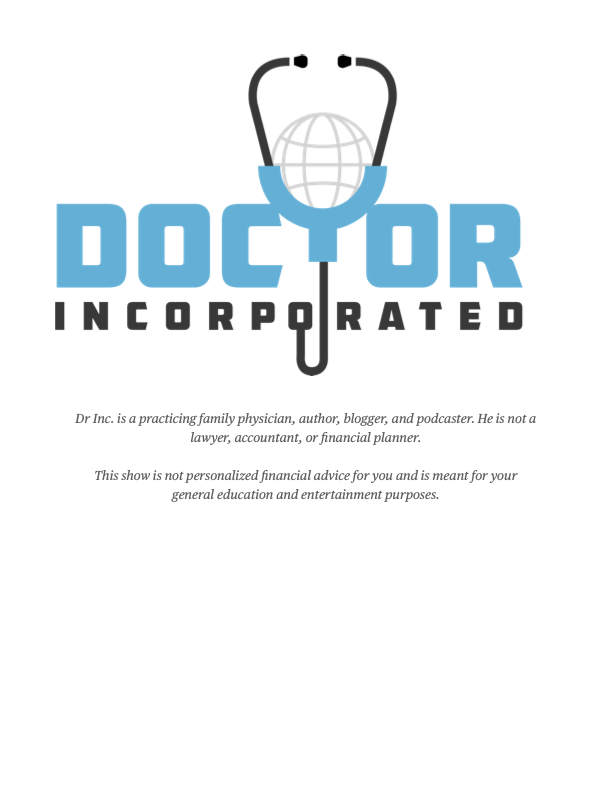
The Pain of Taxes For High-Income Earners
Physicians’ average tax bill for their family is more than $75,000 annually which places them in the top 10% of all taxpayers according to research with the tax foundation, and as documented in a recent Medscape survey on doctors and taxes.
You were likely reminded of this large tax bill when you filed your taxes this year—it’s kinda painful to look at those gaudy numbers—especially when you are a W-2 earner who has a shrinking number of options to reduce your tax burden. It is indolent as it is deducted from your paycheck—mostly invisible to you—but when it’s all added up at tax time—the total is strikingly large.
As if that isn’t enough President Biden has vowed to target you to pay more taxes when he explicitly stated he was coming after those who earn over $400,000 a year.
How Can You Pay Fewer Taxes?
It brings up the invertible question that most doctors ponder at least once a year: “How can I pay fewer taxes and keep more of my money”.
With as much as 70% of doctors working as employees nowadays, the real question is how can a physician working as a W-2 employee reduce his/her taxes. The options for high-income earners like doctors are found in a shrinking menu of tax deductions. But it does still include:
-
Maximize retirement contributions: Contributing to retirement accounts like 401(k)s and IRAs can help reduce taxable income.
-
Take advantage of medical expense deductions: Many medical expenses not covered by insurance may be deductible on your federal return. Any medical expenses that exceed 7.5% of your adjusted gross income may be deductible from your taxes.
-
Make charitable contributions: Donating to qualified charities is an easy way to lower your taxable income without having to itemize deductions. My wife and I like to use a donor-advised fund from fidelity for sharing our resources with those in need.
-
Claim dependents: Claiming dependents on your taxes can help reduce your tax burden significantly.
-
Take advantage of state-level tax credits and deductions: Different states offer different types of tax breaks for physicians, so make sure you research what’s available in your state
-
Take advantage of mortgage and student loan deductions. For example, if you have student loans, you may be able to deduct up to $2,500 in interest payments each year from your taxable income.
What Else? Incorporate Yourself
There are a lot of creative and convoluted actions that high-income earners will take in order to reduce their tax burden. Some of the maneuvers are questionable and others are just frankly illegal.
The one that I find the most compelling is to start a business.
For you, the easiest way to start a business is to incorporate yourself as a professional corporation (PC). Your medical license provides you the special power to do this—as you are among a small group of service professionals who a granted the option. A PC will allow you to take advantage of additional tax benefits available to businesses—that are unavailable to individual taxpayers— such as lower self-employment tax rates and more favorable income taxation rules for corporations.
In response to this, a lot of you will reflexively shoot down this idea because: “I chose to be an employee so that I didn’t have to run a business”, or “I don’t want to go into private practice, it’s too complicated and risky”.
Both are legitimate mindsets, but neither applies to the formation of “Dr. You, Inc.”—which is a professional micro-corporation that is virtual and has a single employee—only you.
A single-member professional corporation taxed as an S-Corp is my favorite foundational business structure that will work for most doctors. However, you can choose from a host of other business structures that provide tax advantages to your professional income—structures that range from sole proprietor, single-member LLCs, Professional Corporations (PC), and Professional LLCs (PLLC).
Which is best for you should be based on a careful analysis of your personal and professional life with a legal or tax professional who can coach and support you.
Feel free to reach out to me at SimpliMD to schedule a free 45-minute coaching session at this link https://calendly.com/drinc/45min
A Case Study
I recently had a physician meet with me through SimpliMD as he had read my new book “Doctor Incorporated: Stop The Insanity of Traditional Employment and Preserve Your Professional Autonomy”. Through the book, he was inspired to view his professional life outside of the framework of traditional employment. He was also stinging from filing his 2022 taxes when he realized that he and his wife had paid $129,000 in taxes.
 Get A Copy Now!
Get A Copy Now!
https://www.doctorincorporatedthebook.com/
His current employment contract was up for renewal, and he had two offers on the table to consider. Both would lead to greater compensation than the previous year. But one hospital, which was his current employer, would only offer him a traditional employee contract (W-2 worker). The other hospital was willing to offer him the same compensation but do it via an employment lite contract through his yet-to-be-formed, professional corporation.
As Is/As If
So he asked our agency to do a feasibility study for him that would evaluate what we call an “As Is and As If” analysis. In this study, we involve an attorney, a physician coach-agent, and an accountant to run a doctor’s personal and professional data through proprietary tax software. The analysis involves real data based on the physician’s actual prior year’s tax return (As Is) and then projects the various tax entities that a doctor can use to receive their income—from individual to corporate options (As If).
It provides firm data that is not a sales job, but actually “proves” which option is better financially in a side-by-side spreadsheet. I love doing this because the numbers don’t lie.
For this doctor, we analyzed his prior tax year and then compared that to what his new job offer-compensation data would look like as a PC taxed as an S-Corp, C-Corp, and staying as a W-2 employee.
From a Tax perspective here is what it looked like:

As you can see, converting to a micro-professional corporation would cut taxes in half!
Yes, I said “HALF”. Wow-that is an eye-popping $80,000 in tax savings!
This is all because of the additional tax channels that are made available to small business owners.
In this doctor’s case, the tax savings were translated into an additional $ that enhanced his annual net worth—including:
-
additional household income of over $25,000 compared to being a W-2 worker
-
TRIPLE the tax-advantaged retirement funding—with the potential for it to be even more through a Cash Balance plan.
In summary, by using an employment lite agreement through his micro Professional Corporation he will be working for the hospital alongside all the other traditional W-2 physician employees, looking just like them, providing the same services, and getting compensated in the same way—still maintaining no management responsibilities.
However, INVISIBLE to all—other than his employer— he will work as a contractor through his own professional micro-corporation. This will lead to him cutting his taxes in half and tripling his retirement savings.
Why wouldn’t any doctor want this?
Simultaneously, he gains professional autonomy and the ability to layer in side jobs and passive income sources that all additively benefit his household and accelerate the growth of his net worth.
This all catapults him into thinking like a businessman and he now plans to use those extra dollars to fund his next small business venture which includes owning his own airplane and doing aviation medicine on the side.
His professional micro-corporation has now become the foundation for his growing entrepreneurial business enterprise.
Who Can Do This?
By now I hope you are asking yourself is there something special about this doctor that makes this all possible?
The answer is no.
Every doctor in America can do the same thing—and it begins with taking the first step—of incorporating yourself.
I believe every doctor in America should form a micro-corporation as the basis for any and every professional activity that they perform.
The tax advantages, business deductions, and professional autonomy gained by this move help to preserve what you have worked so hard to earn—your status as a professional who can operate both as an individual tax entity and as a single-owner corporate tax entity.
I Did It
How do I know all this? Because several years ago, discovered this hidden option after working as a traditional W-2 employee for 15 years. Here is what my personal case study looked like when I evaluated whether it would be wise to start a PC and convert to an employment lite contract:

Like any good scientist, I needed to see the “proof” in the numbers before making the decision to do it. You’ll note that my analysis was less focused on tax savings and was more focused on household financial benefits. Both are important and they are very tied together—because your tax savings are what fuel your net household benefits. The end result is retained earnings.
Put another way—you keep more without working more.
As you can see in my case, by starting a PC and converting to an employment lite agreement my net household financial benefit (post-tax) was $70,000, or $700,000 over 10 years.
In essence, choosing to be a W-2 employee was costing me $700,000 every ten years—close to a million dollars!
Translated another way, by retaining that million dollars over 10-15 years, I could FIRE-Coast or FIRE much sooner than if I were a W-2 employee.
I call that working smarter, not harder.
And over the past nearly 10 years, this has indeed proved out—and thus I will retire from my primary clinical practice 12 months from now— in my late 50s.
Had I known what I know now, I would have reached the stage of financial independence/freedom a decade earlier. Fortunately for most of you, the stages of financial security and financial flexibility are innately associated with your high income—but I invite you to strive for one of the last 3 stages in your financial journey—and at least arrive at financial independence.

Ownership first involves forming a professional micro-corporation that is conjoined to you as an individual. When a doctor does this, now they have empowered themselves to have tax classification options for every job situation–that range from individual to business classifications. Service professionals like doctors, lawyers, and accountants are given this superpower. Many doctors have forgotten they have it.
That dual individual and business classification opens the door to all job options that include:
Individual to Business Relationships:
-traditional employment
-joining a medical group/partnership
Business-to-Business Relationships:
-Employment Lite
-Side Professional Work
-Locums Tenens
-Telemedicine jobs
-Shareholder in a medical group corporation—most doctors are unaware that they can join a group or partnership as a micro-corporation rather than as an individual.
Business to Individual Relationships:
-Direct primary care and direct specialty care models
-Cash-only medical practices
-Direct to consumer medical care of any type, for example, “Hims” or “Roman”
-Concierge/Lifestyle Medicine
-Integrated Medicine
-Precision Medicine
Choosing which business classification is best for you is individualized to your job, life architecture, and income channels.
Start Your Own Business!
As these case studies demonstrate, PC owners who contract out their 1099 work have significantly more options to reduce their tax burden than traditionally employed W-2 doctors.
So, become a small business owner and incorporate yourself!
You can take the next step by scheduling a free business coaching session with me worth $500—just make an appointment here for a no-pressure Zoom call. https://calendly.com/drinc/45min









0 Comments